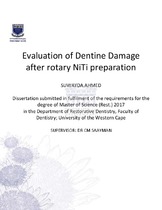| dc.description.abstract | NiTi rotary instruments have shape memory and are highly flexible and super-elastic. These properties of the metal alloy allows for ease of root canal preparation to ultimately result in a root canal preparation that has a continuous taper, while canal shape and curvature is maintained. It must be noted that the NiTi rotary instrumentation may have an effect on root canal dentine, which may manifest as dentine damage. Different NiTi rotary systems on the market vary with regards to their design features and kinematics, which may influence dentine damage. The purpose of this in-vitro study was to compare the effect of four different NiTi rotary systems, as well as stainless steel files on root canal dentine. One hundred and eighty permanent human mandibular molar mesial roots were used for the study. The total samples were randomly divided into six groups, where one group (n=30) was left unprepared to serve as the control group. The remaining five groups were randomly assigned to a nickel-titanium rotary instrumentation system and one stainless steel hand file group. Group 1: Control group; Group 2: Stainless steel files group; Group 3: Wave One (Dentsply Maillefer) rotary group; Group 4: ProTaper NEXT (Dentsply Maillefer) rotary group; Group 5: iRaCe (FKG Dentaire) rotary group; Group 6: BT-Race (FKG Dentaire) rotary group.The root canal preparations were carried out according to the manufacturers' recommendations, after decoronation of the tooth crowns. Sodium hypochlorite (5,25%) and 17% EDTA was used as a root canal irrigant and a chelating agent during canal preparation. Each root segment was sectioned at 3mm, 6mm and 9mm from the apex. The root segments were observed under a stereomicroscope at 12x magnification and digital camera at 40 x magnification for the appearance of dentine damage. The images were observed by the author and an impartial second observer. Root segments were observed for the appearance of dentine damage (microcracks, craze lines or fractures), and samples were described as having 'dentine defect' or 'no dentine defect'. Data for the different groups were collected and results were calculated and the total incidence of dentine damage was as follows: Control group = 0% Stainless steel hand files group = 0% Wave One group = 56, 67% ProTaper NEXT group = 60% iRaCe group = 60% BT-Race group = 56, 67% There are no significant differences between the groups: WaveOne, ProTaper NEXT, iRACE and BT-Race. However, there is a significant difference between the four groups and the stainless steel group (p<0.0001). | en_US |

